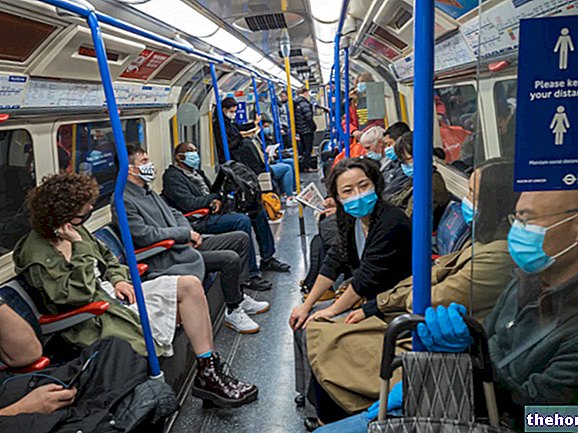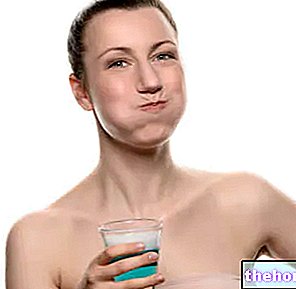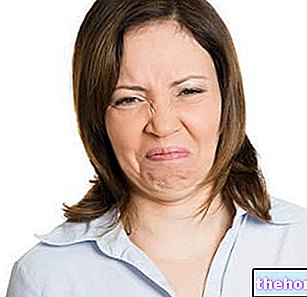Feeling cold in the hands and feet is a very common sensation, especially for women.

Physiologically, cold hands and feet are the result of a phenomenon called vasoconstriction or vasospasm. In other words, the body counteracts the atmospheric cold by reducing the flow of blood to the peripheries, in order to reduce the loss of body heat.
Cold hands and feet are often associated with:
- Pallor: loss of color due to reduced blood flow.
- Reduction: decreasing the volume of circulating blood also reduces the thickness of the soft tissues. It is evident in the fit of the shoes for the feet and the rings for the hands.
The published material is intended to allow quick access to general advice, suggestions and remedies that doctors and textbooks usually dispense for the treatment of cold hands and feet; such indications must in no way substitute the opinion of the attending physician or other health specialists in the sector who are treating the patient.
What to do
- Quitting smoking: nicotine exerts a vasoconstricting effect.
- ONLY if the external temperature to which one is subjected is not excessively low, it is possible to drink half an alcoholic unit (about half a glass of wine); better if not on an empty stomach.
- Cover the extremities of the body more with clothing made of special material, preferably thermal.
- Dress comfortably, not tightly: often the hands and feet become cold due to the pressure exerted by shoes, gloves, trousers or shirts (the latter two can tighten on the thigh, calf, arm or forearm ). This phenomenon is of a physical nature and represents a vasoconstriction that sometimes verges on hemostasis (blockage or significant slowing of the circulation).
- Periodically stretch and move your fingers and toes to reactivate blood circulation.
- Pay more attention to the practice of sports and activities that can hyper-sensitize the extremities of the body. Eg:
- Scuba diving in the winter and spring months: water conducts heat more effectively than air. The feet suffer above all, further compressed by the fit of the fins. In addition, pressure promotes peripheral vasoconstriction and increases diuresis (resulting in dehydration).
- In addition, it is essential to find a way to urinate out of the suit during prolonged dives that involve numerous freediving dives (several hours). Some solutions for males are:
- External catheter (adhesive around the penis and communicating to the outside with a rubber tube).
- Duck beak (condom similar to a neoprene condom with a hole at the top).
- Periodic stops; on the other hand, they plan to undress outdoors (they can be counterproductive).
- Cycling: The hands and feet are deprived of blood, which is concentrated in the thigh muscles and buttocks. Moreover, the forced air of the wind cools the body faster.
- Thanks to a correct diet, prevent / cure some discomforts or metabolic complications with a predominantly nutritional etiology:
- Low pressure:
- See Low Blood Pressure Remedies.
- Anemia.
- See Anemia Remedies.
- Dehydration.
- See Dehydration Remedies.
- If you have other symptoms, see your doctor to rule out the possibility of a disease:
- Raynaud's syndrome: mainly affects women between the ages of 20 and 40. Other related symptoms in the hands and feet are:
- Bluish color.
- Soreness.
- Numbness.
- Sometimes tremors.
- Hypothyroidism: impairment of the function of the thyroid gland. Other related symptoms are:
- Chronic weakness.
- Undue weight gain.
- Peripheral atheropathy: vasoconstriction caused above all by atherosclerosis (secondarily by thrombi and emboli, instead responsible for total and acute obstruction, therefore more serious). Other related symptoms are:
- Erectile dysfunction.
- Intermittent lameness.
- In case of a positive diagnosis, treat the disease in question:
- For Raynaud's syndrome:
- Pharmacological therapy: the type of molecule varies according to the etiology (primary or secondary Raynaud).
- For hypothyroidism:
- Drug therapy: replaces missing hormones.
- Supplementation of iodine in the diet (if hypothyroidism is of nutritional cause).
- In case of tumor, toxic goiter, nodules, etc., surgery may be required.
- For peripheral atheropathy:
- Drug therapy: in case of clots, a drug is given to prevent or dissolve them. This is a very rare eventuality.
- Surgery, if atherosclerosis is very severe.
- In case of drug therapy with beta-blockers, the doctor may choose to change the type of drug to reduce the side effect of cold hands and feet.
What NOT to do
- Smoking: Nicotine has a vasoconstricting action and can worsen the sensation of cold hands and feet.
- Excess with alcohol: since alcohol has a vasodilating effect and inhibits sensory perception, some people tend to drink excessively so as not to feel the cold. This is wrong and dangerous, especially in the presence of low temperatures: prolonged vasodilation can cause a "excessive heat dissipation. Sometimes there is also a rebound effect, with vasoconstriction following the reduction of alcohol in the blood and consequent worsening of cold hands and feet. Furthermore, ethyl alcohol promotes dehydration and reduction of blood volume.
- Handle very cold objects with bare hands.
- Keep your hands, feet and fingers still for long periods of time.
- Walking barefoot on stone floors.
- Donate blood or have blood drawn (this is especially true in case of low blood pressure, anemia or dehydration).
- Excessively bandaging the ends.
- Underestimate particular conditions such as: underwater activities, exposure to drafts, etc.
- Maintain beta-blocker therapy in case your doctor suggests trying an alternative medication
- Do not treat pathologies or discomforts potentially responsible for the cold in the hands and feet. For example: anemia, low blood pressure, dehydration, Raynaud's syndrome, hypothyroidism and peripheral atheropathy.
- Neglect any side effects of drug therapies. For example, in the treatment of Raynaud's syndrome with nifedipine, the following may appear:
- Edema of the hands and feet.
- Headache.
- Hot flashes.
- Dizziness.
What to eat
- Chilli and foods that contain it: capsaicin in chilli has a vasodilating effect.
- In case of anemia, follow a diet rich in:
- Iron, especially bioavailable (heme and ferrous).
- Folic acid.
- Vitamin B12.
- C vitamin.
- In case of low blood pressure, follow a diet rich in:
- Waterfall.
- Potassium and sodium.
- Licorice (thanks to the glycyrizin content which increases pressure).
- Foods containing carbohydrates, in small but frequent portions.
- In case of dehydration: consume mainly foods rich in water, carbohydrates and minerals (especially potassium).
NB. Certain minerals (especially iron) can complex with anti-nutritional agents, such as oxalic acid, phytic acid and tannins, inside the intestine; consequently they are not absorbed. Therefore it is advisable not to exceed with fibers and raw foods that abound in these molecules (bran, raw legumes, rhubarb, spinach, etc.).
NB. Some vitamins are thermolabile (vitamin C and folic acid) and degrade with cooking. To ensure its intake, it is advisable to eat most of the foods that contain it in raw form.
What NOT to Eat
- Coffee: Caffeine is a vasoconstrictor.
- In case of anemia: avoid following a diet based exclusively on cooked foods and limit foods rich in anti-nutritional agents. Also avoid ethyl alcohol.
- In case of low blood pressure, avoid:
- Long fasts.
- Ketogenic diets.
- Diets low in water and minerals.
- Alcoholic beverages.
- In case of dehydration, avoid:
- All products stored.
- Ethyl alcohol.
- Stimulants: caffeine etc.
- Diuretic officinal plants (for example dandelion and asparagus).
Natural Cures and Remedies
- Ethyl alcohol: Small doses of alcohol can temporarily contribute to the reduction of cold hands and feet.
- Herbal remedies:
- Ginko biloba leaves.
- Hot pepper.
- For nutritional based hypothyroidism:
- Supplements of iodine (mineral), selenium and amino acid L-tyrosine: these are the substrates necessary for the synthesis of thyroid hormones.
- In case of anemia: iron supplements, folic acid, vitamin B12 and vitamin C.
- In case of low blood pressure:
- Chew licorice root sticks.
- Water, glucose and mineral salts supplements (for example those for sports).
- In case of dehydration:
- Water, glucose and mineral salts supplements (as above).
- Some suggest to practice food supplementation with plants or active ingredients that could improve the elasticity of blood vessels (capillarotropes). There is no scientific basis to support this hypothesis.
Pharmacological treatment
- Drug therapy for Raynaud's syndrome:
- Calcium channel blockers: for example nifedipine (such as Adalat®).
- Alpha blockers: e.g. doxazosin, terazosin, tamsulosin, alfuzosin etc.
- Vasodilators: e.g. hydralazine, phosphodiesterase inhibitors, potassium channel activators, vasodilating nitro-derivatives, slow calcium channel antagonists, etc.
- Drug therapy for hypothyroidism:
- Replacement hormone: it is based on Levothyroxine sodium (for example Eutirox ®, Syntroxine ®, Tiracrin ®, Tirosint ®), Liothyronine sodium (for example Liotir ®, Titre ®) etc.
- Drug therapy for thrombus and emboli:
- Antiplatelet drugs, anticoagulants, thrombolytics: they act with different mechanisms but they all have the function of avoiding the obstruction of the vessels. For example: salicylates (such as Aspirin ®), Dipyridamole (such as Persantin ®), clopidogrel (such as Plavix ®) etc.
Prevention
The prevention of cold in the feet and hands includes most of the precautions mentioned above. In summary:
- Stop smoking.
- Don't overdo the caffeine.
- Drink alcohol in moderation, only on a full stomach and never during exposure to very cold temperatures.
- Ensure protection from the cold.
- Promote circulation.
- Pay attention to clothing and other important details when carrying out particular activities practiced in the cold.
- Preventing disadvantageous metabolic conditions such as anemia, low blood pressure and dehydration.
- Treating responsible pathologies such as: Raynaud's syndrome, hypothyroidism and peripheral atheropathy.
- Follow a correct and balanced diet, avoiding fasting.
Medical Treatments
There are no medical treatments aimed at improving cold hands and feet. The only exceptions are referred to the treatment of primary pathologies, for example atheroparia surgery.





-cos-cause-e-disturbi-associati.jpg)

















-nelle-carni-di-maiale.jpg)




